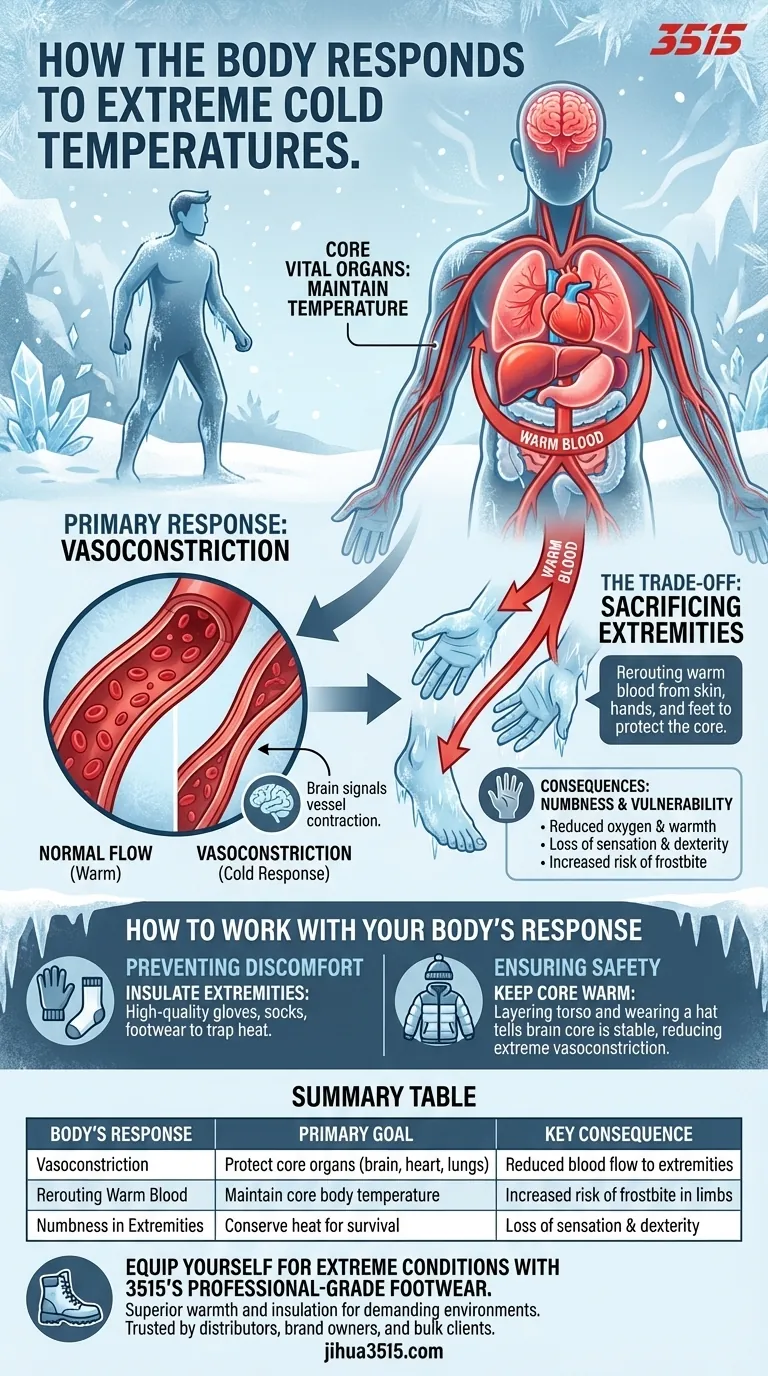In extreme cold, your body's primary response is a survival mechanism called vasoconstriction. To protect your vital organs, it intentionally sacrifices warmth in your extremities by narrowing the blood vessels in your skin, hands, and feet, rerouting warm blood to your core.
Your body's reaction to cold is not a failure, but a deliberate and strategic trade-off. It prioritizes the survival of your vital organs by sacrificing comfort and safety in your limbs.

The Core Principle: Protecting the Vitals
Your body's central mission in extreme cold is to maintain its core temperature. The brain, heart, lungs, and other internal organs must stay within a very narrow temperature range to function properly.
The Key Mechanism: Vasoconstriction
Vasoconstriction is the tightening of blood vessels. When your brain senses a dangerous drop in temperature, it signals the muscles in the walls of your blood vessels near the skin's surface to contract.
Rerouting Warm Blood
This tightening dramatically reduces blood flow to your skin and extremities. By doing so, your body creates an insulating layer, keeping the warm blood circulating deep within your torso where your most critical organs are housed.
Understanding the Trade-offs
This survival strategy is highly effective, but it comes with significant risks and consequences for the parts of the body that are cut off from the warm blood supply.
Why Your Fingers and Toes Go Numb
The tingling and numbness you feel in your hands and feet are the first signs of this process. With reduced blood flow, these areas receive less oxygen and warmth, leading to a loss of sensation and dexterity.
The Consequence: Increased Vulnerability
This is the inherent danger in the body's response. While the core stays protected, the extremities become highly vulnerable to cold-related injuries like frostbite. The lack of warm blood flow means the tissue itself can begin to freeze and sustain damage.
How to Work With Your Body's Response
Understanding this process allows you to prepare and react more effectively.
- If your primary focus is preventing initial discomfort: Insulate your extremities. High-quality gloves, socks, and footwear help trap heat, slowing the rate at which your hands and feet lose warmth despite reduced blood flow.
- If your primary focus is safety in prolonged cold: Keep your core warm. Layering clothing on your torso and wearing a hat tells your brain that the core temperature is stable, reducing the need for extreme vasoconstriction and protecting your limbs.
By respecting this powerful survival instinct, you can better protect your entire body from the dangers of the cold.
Summary Table:
| Body's Response | Primary Goal | Key Consequence |
|---|---|---|
| Vasoconstriction | Protect core organs (brain, heart, lungs) | Reduced blood flow to extremities |
| Rerouting Warm Blood | Maintain core body temperature | Increased risk of frostbite in limbs |
| Numbness in Extremities | Conserve heat for survival | Loss of sensation and dexterity |
Equip yourself for extreme conditions with 3515's professional-grade footwear. As a large-scale manufacturer, we produce a comprehensive range of insulated boots and footwear designed to protect your extremities by providing superior warmth and insulation. Our products are trusted by distributors, brand owners, and bulk clients for demanding environments. Don't let the cold compromise safety—contact our team today to find the perfect protective footwear solution for your needs.
Visual Guide

Related Products
- Durable Rubber Sole Outdoor Shoes Wholesale & Custom Manufacturing
- Durable Mid-Cut Tactical Boots for Wholesale & Private Label
- Wholesale Durable Mid-Cut Tactical Boots for Custom & Private Label Brands
- Wholesale Durable Safety Boots Manufacturer Customizable Steel Toe Work Boots
- Custom Wholesale Leather Safety Boots Direct Factory Manufacturing
People Also Ask
- What should be considered when choosing hiking boots for snake protection? Prioritize Fit & Materials for Safety
- How do hiking shoes or boots protect feet from environmental hazards? A Guide to Trail-Ready Footwear
- What are the disadvantages of vulcanized soles? Lack of Support & Durability Explained
- Why are rubber-soled shoes considered multi-weather footwear? Unlock All-Season Traction & Protection
- What were traditional shoe soles made from before rubber? The History of Leather Soles



















